HISTORICAL SITES

For more pictures........
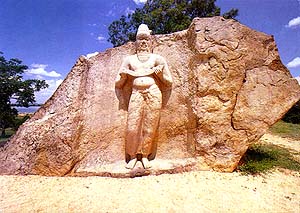
|
|
Parakramabahu the Great - Polonnaruwa
|
On the Southern side of the Parakrama Samudra (Polonnaruwa) is a striking
stone statue of a bearded man holding in his hands what seems to be book
(written on palm leaves). The care-worn expression hints at royalty and popular
belief identifies it as a statue of Parakramabahu the Great.

|
|
Kelaniya Temple
|
The
traditional Sri Lankan dagoba (from which the word "pagoda" is derived) is a
hemi-spheric or bell-shaped structure of bricks and earth sitting on a square
platform. At the peak of this structure is a tapering spire topped by a gilded
ornament. The whole structure is usually surrounded by a walled courtyard
containing statues of Buddha and his deciples, various deities, places to offer
flowers, and large empty area for religious gatherings. In the same property
there generally is a sacred Bo (peepul) tree as well.
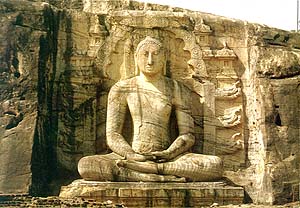
|
|
Gal Vihara at Polonnaruwa
|
Cut
from a single granite wall, the statues of Lord Buddha, at Gal Vihara (rock
shrine), in Polonnaruwa,
rank among the finest in Sri Lanka. The statues were carved out in 12th century
A.D., and has weathered the elements remarkably un-touched. The statue shown
here is that of the seated Lord Buddha.
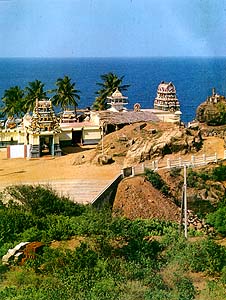
|
|
Tirukoneswaram Kovil - Trincomalee
|
Trincomalee is a
natural deep-water harbor, on the north-east coast of Sri Lanka. On the east
side of the town of Trincomalee, on a cliff known as Swami Rock stands one of
the oldest Kovils (Hindu temple) in Sri Lanka. The present day
Tirukonesvaram Kovil was rebuilt on the site of the Dakshana Kailayam
(temple of 100 pillars) - that was destroyed by the Portugese in the 17th
century. The restoration work was completed in the 1960's, and it is a "must
see" site, for the visitors to Trincomalee. Friday evening Puja
(offerings) services are specially colorful.
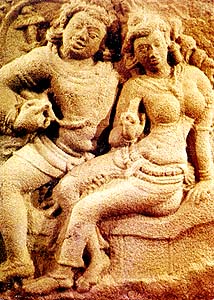
|
|
Isurumuniya Lovers - Anuradhapura
|
Isurumuniya
temple, in Anuradhapura,
built in the 3rd century B.C. is noted for its rock carvings. The best known
among these is the "Lovers". Many a poet and song writer has taken inspiration
from this carving to write their masterpieces. It is believed that the carving
may represent Saliya, and the low-caste maiden whom he loved. Saliya was the son
of the great king Dutugamunu.
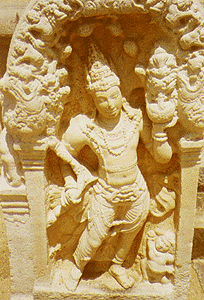
|
|
A Gurard Stone at Thuparama
|
A
guard stone at Thuparama, in Anuradhapura. North of the famous Ruwanveli Seya,
Thuparama is considered to be the oldest dagoba in Sri Lanka and is believed to
enshrine the collar bone relic of Lord Buddha. The guard stones like these are
generally found in pairs at the entrance to temples, palaces and other revered
sites.
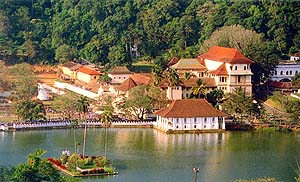
|
|
City of Kandy with the lake in the foreground
|
Kandy, the
last capital of Sinhala kings, nestled in the foothills of the Hill Country,
with its beautiful lake at the center, is the center of traditional Sri Lankan
Culture.
Kandy, the anglicization of the Sinhala word kande, meaning
"hill" is about 1600 feet (488 meters) above sea level and is the favorite city
of travelers from all over the world. The sacred tooth of Lord Buddha is
preserved here in it's own temple "Dalada Maligawa" ( The temple of the
Tooth ) and a replica of this holy relic is paraded around the city, on the back
of the chief elephant "Raja", for two weeks every year during the month of
August. Esala Perahera or the parade during the month of Esala is
a spectacle not to be missed, with hundreds of brightly decorated elephants,
dancers and singers from all walks of life, who turn this normally quiet small
town to into one enormous festival, during those two weeks.
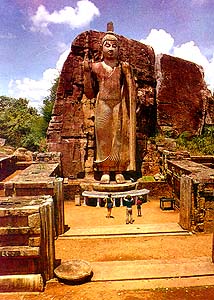
|
|
Aukana Buddha
|
This
42 1/2 feet (13 meters) high statue carved out of solid granite, goes back to
the 5th century, to the reign of King Dathusena. On a rainy day, it is said,
that one can see droplets of water falling off the tip of the statue's nose
hitting the ground exactly between the toes.- a testament to the architectural
accuracy of the sculptor. Aukana is about 32 miles south-east of Anuradhapura.
Several years ago authorities decided that the modern day pollutants are taking
its toll on this ancient statue and erected a brick enclosure around and above
it. To this day, this remains somewhat controversial.
Popularly
regarded as the greatest, and certainly the most popular among the Buddhists, of
the stupas at Anuradhapura, Ruwanveli Seya, is the pride of the Great
Emperor Dutugamunu. Raised in the 2nd century B.C. this dagoba is supposed to
have the perfect water bubble shape. There are four gate houses marking the
outer walls of this magnificant structure, and within the courtyard a receantly
built "elephant wall" upholds the dagoba platform. Among the many statues in the
courtyard there is one that is of a larger-than-life man. This is considered to
be the king himself watching his work from a respectable distance.
For more pictures........
The
rock fortress Sigiriya,
rises some 600 feet above the scrub jungle plain in the north central part of
Sri Lanka. It is this very feature that drove young prince Kasyapa, after
killing his father King Dhatusena, by entombing him alive, to this lonely rock
in the jungle to hide from his older brother who was gathering an army to retake
the throne. Kasyapa while in self imposed exile made his new kingdom as liveable
and pleasant as possible by surrounding himself with his loyal followers, and
for his personal enjoyment, what could only be described as "pinups". These
frescos are to this day preserved in a grotto in the sheer west face of the
rock.
The top of the rock in itself is a marvel of agro-engineering. About 3 acres
in area, every square foot was utilized. Bathing pools were cut out of living
rock and every drop of (rain) water was used and re-used. Sigiriya (lion's
throat) was so named because the visitors had to go through the throat of a lion
to get to the top of the rock.
Today Sigiriya is a bustling tourist mecca with world class hotels for the
weary traveler.
Fortress from the sky - Sigiriya
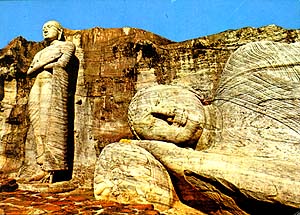
|
|
Gal Vihara -Polonnaruwa
|
Another
view of the Statues of Gal Vihara at Polonnaruwa.
The standing figure some 23 feet (7 meters) high is believed to represent
Arahath Ananda, Lord Buddha's favorite deciple. The reclining statue, some 46
feet (14 meters) is believed to be that of Lord Buddha at the moment of his
entry into parinibbana (death).
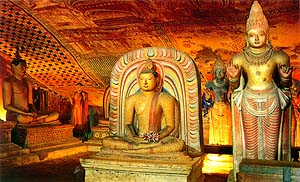
|
|
Buddha Statues at Dambulla Cave Temple
|
For more pictures........
Back to Images of Sri Lanka

NEW COUNTER INSTALLED SINCE 1 AUGUST 2001
![]()


